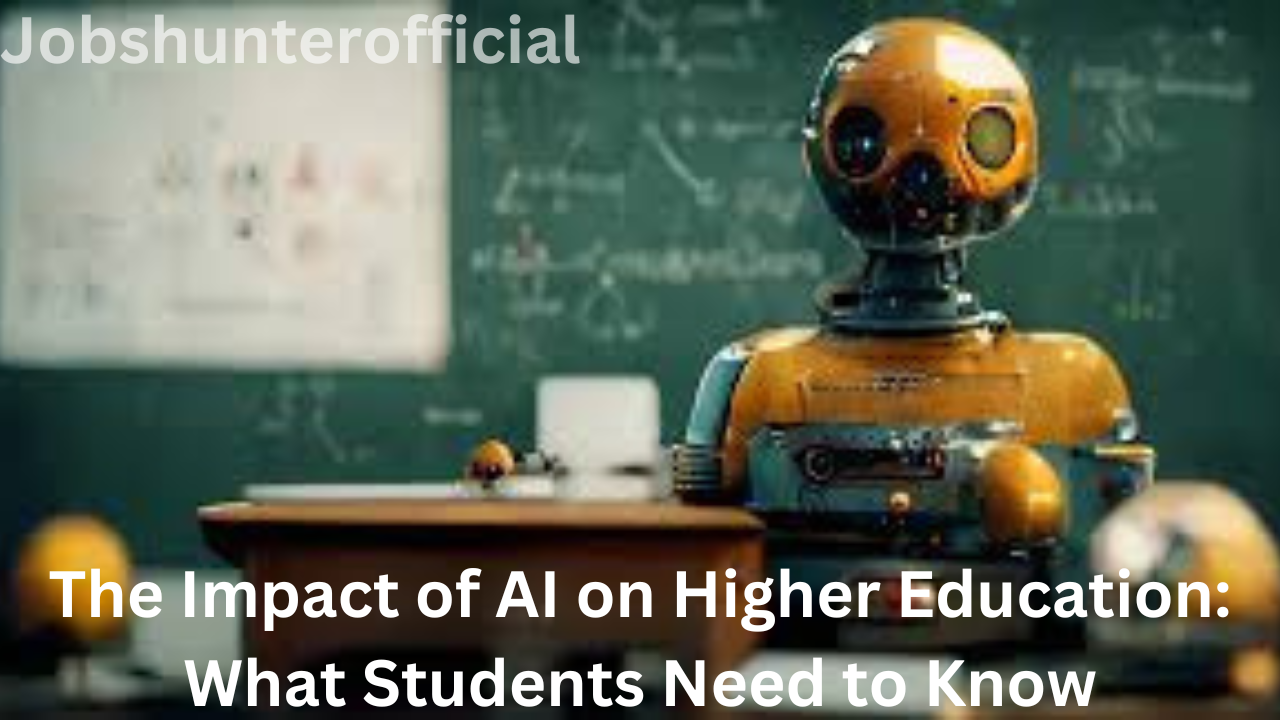Introduction
The Impact of AI on Higher Education: Higher education is not an exception to how artificial intelligence (AI) is transforming numerous industries. The way educators educate, how students learn, and how institutions function are all being changed by the incorporation of AI technologies into educational settings. Students who wish to make the most of their academic and professional possibilities must comprehend how artificial intelligence is affecting higher education. This article examines how AI is changing higher education, emphasizing the technology’s advantages, drawbacks, and potential future applications.
Enhancing Learning Experiences–The Impact of AI on Higher Education
Personalized Learning
AI makes it possible to customize learning programs to meet the needs of each unique student. AI is able to evaluate a student’s learning preferences, areas of strength and weakness, and data through complex algorithms. With the use of this data, personalized learning routes may be developed, guaranteeing that students get the best guidance and assistance possible.
- Adaptive Learning Platforms: Tools like Coursera and Khan Academy use AI to adjust the difficulty of material based on student performance, providing a more personalized and efficient learning experience.
- Intelligent Tutoring Systems: These systems offer real-time feedback and personalized instruction, helping students master subjects more effectively.
Automated Grading and Feedback
Artificial intelligence (AI)-powered solutions can grade assignments automatically and give quick feedback. Teachers not only save time by doing this, but students can also get timely and reliable feedback on their work.
- Essay Scoring: AI systems like Grammarly and Turnitin can evaluate written assignments for grammar, style, and originality, providing students with valuable feedback.
- Quizzes and Exams: Automated grading systems can quickly assess multiple-choice and short-answer questions, giving students rapid insight into their performance.
Supporting Educators
Enhanced Instructional Tools
AI provides educators with advanced tools to enhance their teaching methods and materials. These tools can analyze classroom interactions, identify areas where students struggle, and suggest instructional improvements.
- AI-Powered Analytics: Platforms like Canvas and Blackboard use AI to track student engagement and performance, helping educators tailor their instruction to better meet student needs.
- Content Creation: AI can assist in creating educational content, such as generating quiz questions, summarizing key concepts, and even creating interactive simulations.
Reducing Administrative Burden
AI can streamline administrative tasks, freeing up educators to focus more on teaching and student interaction.
- Scheduling and Planning: AI systems can optimize class schedules, manage course enrollments, and automate routine administrative tasks.
- Communication: AI chatbots can handle routine student inquiries, provide information about courses, deadlines, and campus resources, reducing the workload on administrative staff.
Transforming Institutional Operations
Data-Driven Decision Making
AI enables universities to make more informed decisions through data analysis. By analyzing vast amounts of data, AI can identify trends, predict outcomes, and optimize resource allocation.
- Enrollment Management: AI can predict enrollment trends, helping institutions plan for future student populations and adjust their offerings accordingly.
- Student Retention: By analyzing factors that contribute to student success and dropout rates, AI can help institutions develop targeted interventions to improve retention.
Enhancing Campus Experience
AI technologies can enhance the overall campus experience for students, making campus services more efficient and accessible.
- Smart Campuses: AI can optimize campus operations, from energy management to security, creating a more sustainable and safe environment.
- Virtual Assistants: AI-driven virtual assistants can help students navigate campus resources, schedule appointments, and access support services.
Preparing for the Future Workforce
AI Literacy
As AI becomes increasingly prevalent, understanding its principles and applications is crucial for students entering the workforce. Many institutions are incorporating AI literacy into their curricula to prepare students for the future job market.
- AI Courses and Programs: Universities are offering courses and degrees in AI, machine learning, and data science, equipping students with the skills needed in a technology-driven economy.
- Interdisciplinary Learning: AI is being integrated into various fields of study, from business to healthcare, providing students with a broad understanding of its impact.
Career Opportunities
AI is creating new career opportunities across industries. Students with AI skills are in high demand, and universities are partnering with industries to provide practical experience and job placement.
- Internships and Co-ops: Many institutions offer AI-focused internships and co-op programs, allowing students to gain hands-on experience in the field.
- Industry Collaboration: Universities are collaborating with tech companies to offer students access to cutting-edge AI tools and research opportunities.
Challenges and Considerations
Ethical and Privacy Concerns
The use of AI in education raises ethical and privacy concerns that need to be addressed. Ensuring that student data is used responsibly and that AI systems are transparent and fair is crucial.
- Data Security: Institutions must implement robust data security measures to protect student information.
- Bias and Fairness: AI systems must be designed to minimize bias and ensure fair treatment of all students.
Accessibility and Equity
While AI has the potential to enhance education, it is important to ensure that its benefits are accessible to all students, regardless of their background.
- Digital Divide: Efforts must be made to bridge the digital divide and provide equal access to AI technologies for all students.
- Inclusive Design: AI tools should be designed with inclusivity in mind, ensuring that they are accessible to students with disabilities.
In summary
AI in higher education is changing the face of education by providing individualized learning experiences, improving teaching strategies, and streamlining institutional procedures. Students must comprehend the implications of artificial intelligence (AI) and be ready for both the benefits and difficulties it will bring as it develops further. Students may use AI to their advantage to succeed academically and professionally by remaining aware and adjusting to these changes.
Related Article : Empowering Futures: A Guide to Florida’s Scholarship Landscape Jobshunterofficial
